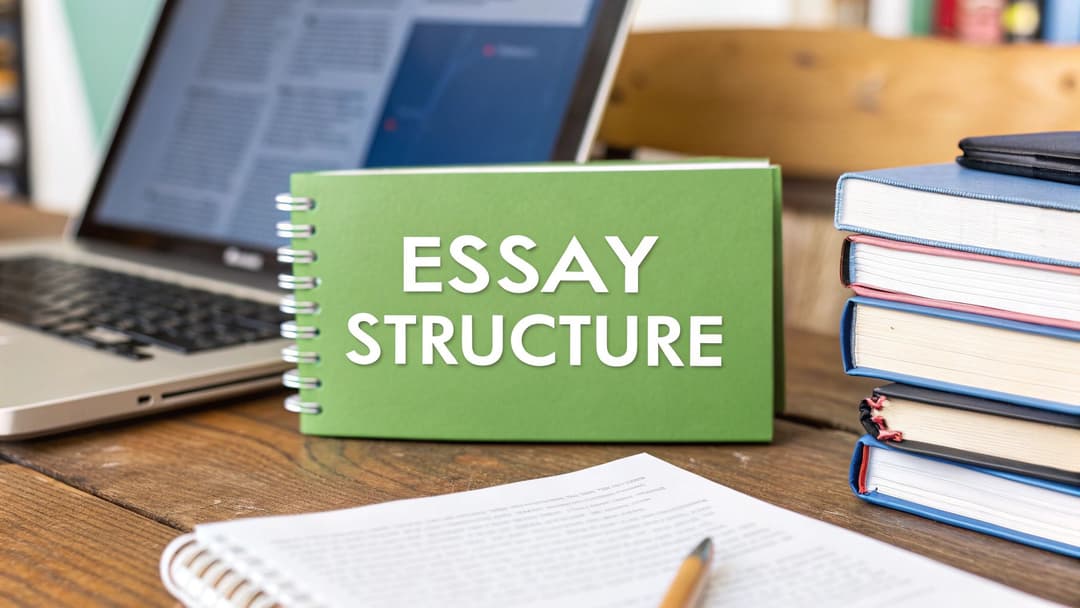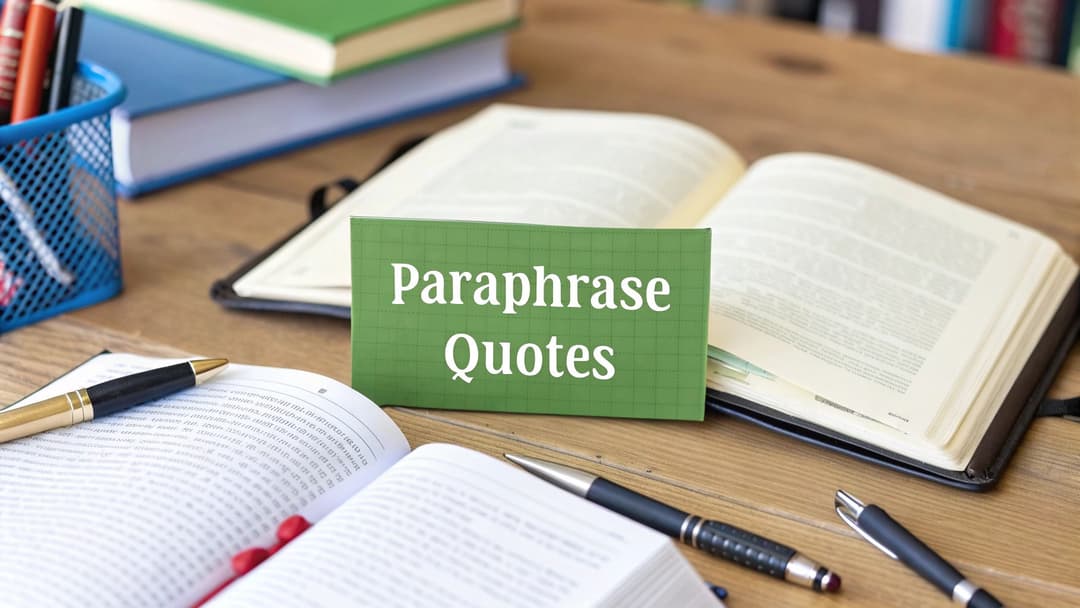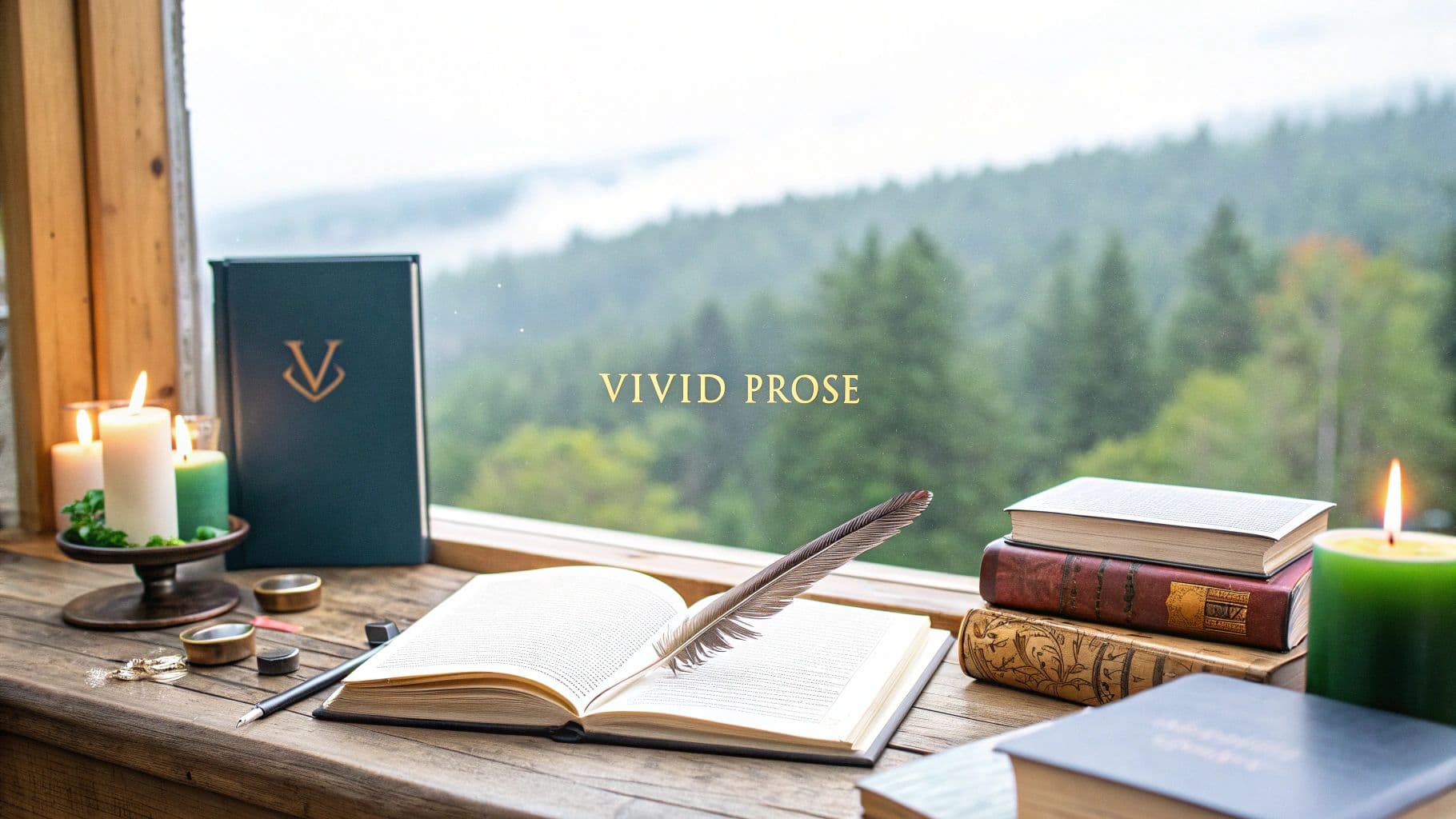
What Is Descriptive Writing? Tips to Make Your Prose Shine
September 30, 2025
Descriptive writing isn't just about listing details; it's the art of painting a vivid picture with words. The goal is to make your reader see, hear, taste, touch, and smell whatever you're describing. It's about creating an immersive experience that pulls them right into the scene.
So, What Is Descriptive Writing, Really?
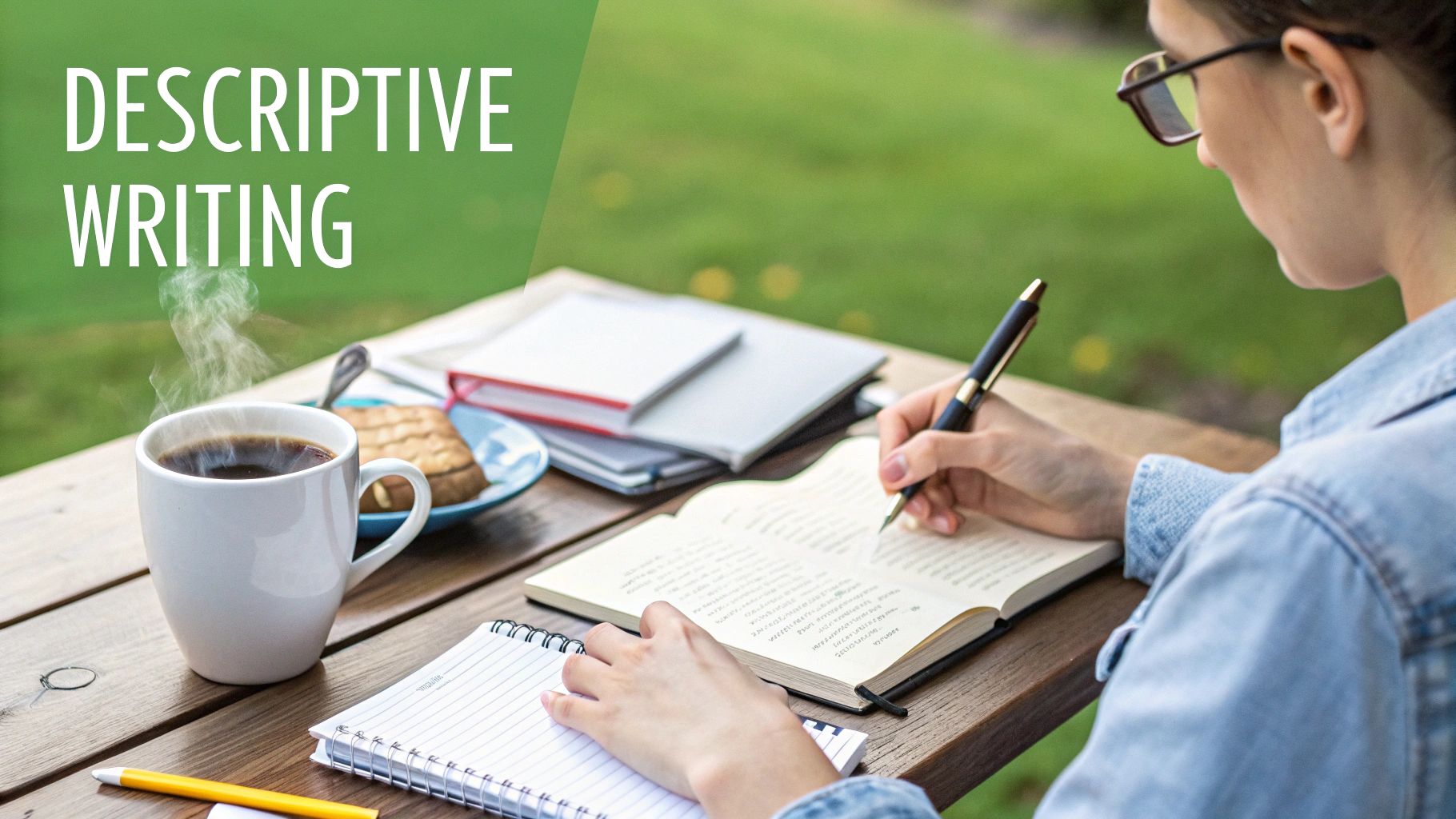
Think of yourself as an artist. But instead of paint and brushes, your tools are precise nouns, powerful verbs, and carefully chosen sensory details. You’re not just reporting what happened—you’re teleporting the reader directly into that moment.
The guiding principle behind all of this is the classic advice: "Show, don't tell." This simple phrase is the key to unlocking truly compelling descriptions.
Telling is just stating a fact: "The room was scary."
Showing is painting a scene that creates the feeling of fear: "The floorboards groaned underfoot, and a stale, dusty air caught in the back of my throat as shadows danced in the corners."
The first statement informs, but the second one makes the reader feel the atmosphere. It brings them into the experience, making it real and memorable. This is one of the most fundamental elements of good writing because it builds a direct bridge between your story and the reader's imagination.
To get this right, you need to master a few core components.
Here's a quick breakdown of the essential elements that bring descriptive writing to life.
The Core Components of Descriptive Writing
| Characteristic | Description | Example Snippet |
|---|---|---|
| Sensory Details | Appeals to the five senses (sight, sound, smell, taste, touch). | "The air smelled of salt and fried dough." |
| Figurative Language | Uses metaphors, similes, and personification to create comparisons. | "The old house stood like a tired giant." |
| Dominant Impression | Focuses on a single mood or feeling you want the reader to experience. | Evoking a sense of overwhelming calm or frantic energy. |
| Precise Language | Chooses specific nouns and strong verbs over generic ones. | "He shuffled down the hallway" instead of "He walked." |
| Careful Organization | Presents details in a logical order (e.g., spatial, chronological). | Describing a room from top to bottom. |
These elements work together to create a cohesive and immersive experience for your reader.
The Purpose of Vivid Description
So why is all this detail so important? Great descriptive writing does more than just decorate your prose; it serves a few crucial functions.
- Creating Atmosphere: It sets the mood, whether you’re aiming for the cheerful chaos of a bustling market or the eerie silence of an empty house at midnight.
- Developing Character: The way you describe a person’s appearance, habits, or even their messy desk can reveal deep truths about their personality without you ever having to state them.
- Building a Believable World: It makes fictional settings feel tangible and real, letting readers fully lose themselves in your story’s environment.
- Evoking Emotion: By tapping into the senses, you can trigger memories and feelings in your reader, forging a powerful emotional connection to your work.
At its core, descriptive writing makes your words stick. It's the difference between a story that's read and a story that's felt.
Engaging the Five Senses in Your Writing

If you want to create a truly immersive experience, you have to go beyond just describing what things look like. The best descriptive writing doesn't just show you a scene; it pulls you into it. It’s the difference between watching a movie and feeling like you’re actually in it.
Think of each sense as a different channel for connecting with your reader. When you start layering these details together, you build a world that feels tangible, memorable, and completely real.
Let's break down how to master each one.
Painting a Picture with Sight
Sight is the sense most writers naturally reach for first. It makes sense—it’s how we primarily navigate the world. But powerful visual writing isn’t about just listing what’s there. Instead of simply stating colors and objects, focus on the small details that hint at a mood or tell a story.
- Generic: "The room was messy."
- Descriptive: "Clothes were strewn across a chair like a collapsed scarecrow, and a half-empty coffee mug left a pale brown ring on a stack of unopened mail."
See the difference? We’ve gone from a flat statement to specific images that let the reader piece the scene together themselves. It shows the mess instead of just telling you it exists.
Crafting a Soundscape
Sound adds a dynamic layer to your writing. It breaks the silence, builds atmosphere, and can even hint at action happening just off the page. Think about not just the sound itself, but its quality—is it sharp or dull? Rhythmic or chaotic?
Even the quietest sounds can define a space. The gentle hum of a refrigerator in an empty kitchen, the distant wail of a siren in a sleeping city, or the crisp crunch of leaves underfoot.
Sound doesn't have to be loud to be powerful. Sometimes, the most effective auditory detail is a quiet one that grounds the reader in the moment, making an otherwise still scene feel alive and breathing.
Evoking Emotion Through Smell
Smell is a shortcut to memory and emotion. A single scent can transport someone to a specific time and place, stirring up nostalgia, comfort, or even disgust. It’s a direct line to the brain's most primitive, emotional centers.
Don’t just name a smell; describe its character. Is it the sharp, clean scent of freshly cut lemons, the musty odor of a forgotten attic, or the warm, comforting aroma of baking bread?
- Weak: "The house smelled old."
- Strong: "The air was thick with the scent of decaying paper and dried lavender, a ghostly perfume of years left behind."
Adding Flavor with Taste
Taste is intensely personal and evocative. You might not use it as often as sight or sound, but deploying it at just the right moment can create a powerful, visceral connection. It's not just for describing food, either—think of the metallic tang of fear or the bitter taste of disappointment.
Here are a few ways to describe taste well:
- Texture: Was it creamy, crunchy, or gritty?
- Temperature: Did it come with a searing heat or an icy chill?
- Complexity: Was it a simple, straightforward sweetness or a complex blend of savory and spicy notes?
For example, turning "the coffee was hot" into "the first sip sent a wave of warmth through her, a bitter, smoky flavor that clung to her tongue" creates a much richer sensory moment.
Grounding the Reader with Touch
Touch is all about connection and texture. It grounds your reader in the physical reality of the world you've built, letting them feel the environment right alongside your characters. Descriptions of touch can convey temperature, texture, pressure, and so much more.
Think about how things actually feel against the skin.
- The prickly wool of a heavy sweater.
- The smooth, cool surface of a marble countertop.
- The sticky warmth of a humid summer afternoon.
By consciously weaving these five sensory threads into your writing, you elevate your prose from a simple description to a fully realized world. This is what turns passive readers into active participants in your story.
Using Figurative Language to Add Depth
If sensory details are the foundation of your writing, grounding it in reality, then figurative language is what makes it soar. It's the difference between a photograph and a painting. A photo shows you exactly what’s there, but a painting gives you an interpretation—an emotional layer, a new perspective. That’s what figurative language does for your words.
This is where your writing moves beyond just describing things. You start inviting the reader to think in new ways, connecting ideas that aren’t obviously related. It’s how you add layers of meaning that a straightforward sentence just can’t touch.
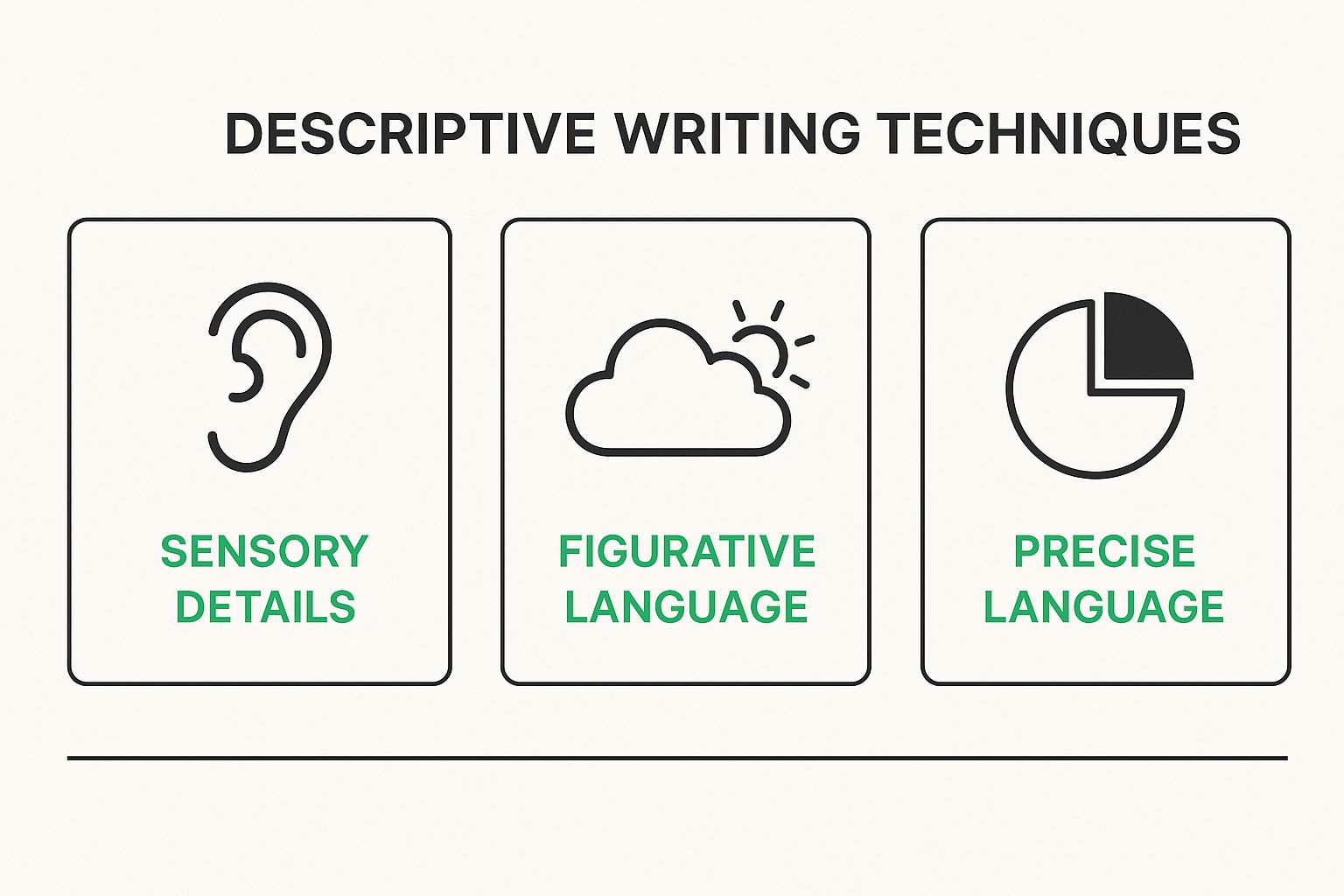
As the image shows, these tools aren't meant to be used in isolation. They work together, each playing a different part in building a world that feels rich and real. Let’s look at a few of the most powerful techniques you can start using right away.
Creating Connections with Similes and Metaphors
Similes and metaphors are the true workhorses of figurative language. Both draw comparisons between two different things to create a surprising connection, but they do it in slightly different ways.
A simile makes a comparison using "like" or "as," which makes the connection clear and direct.
- The old car sputtered down the road like a tired man after a long day.
- Her voice was as crisp as autumn leaves underfoot.
A metaphor, on the other hand, is more direct—it says one thing is another. This creates a stronger, more immediate image in the reader's mind.
- The old car was a tired man, sputtering down the road at the end of a long day.
- Her voice was crisp autumn leaves crunching underfoot.
Whether you choose a simile or a metaphor really depends on the feel you're going for. Similes can feel a bit gentler, more poetic. Metaphors tend to be bolder and more assertive.
To help you keep them straight, here’s a quick guide.
Simile vs Metaphor: A Quick Guide
This simple comparison will help you distinguish between these two powerful figurative language tools and use them effectively.
| Technique | Definition | Example |
|---|---|---|
| Simile | Compares two unlike things using "like" or "as." | The moon hung in the sky like a silver coin. |
| Metaphor | States that one thing is another, without "like" or "as." | The moon was a silver coin in the night sky. |
Ultimately, a good comparison feels fresh. Try to steer clear of clichés like "busy as a bee." The best similes and metaphors are the ones that make someone pause and see something familiar in a whole new way.
Bringing a Scene to Life with Personification and Hyperbole
Beyond direct comparisons, you can really make your writing pop by giving human qualities to inanimate objects or by using a bit of strategic exaggeration.
Personification gives human traits or actions to non-human things. It’s a fantastic way to build atmosphere and make a setting feel like it has a life of its own.
- Instead of: "The wind blew."
- Try: "The wind complained at the window."
Hyperbole is just a fancy word for deliberate exaggeration. You’re not trying to be literal; you’re trying to create a dramatic effect or emphasize a feeling.
- Instead of: "I waited a long time."
- Try: "I waited for an eternity at the checkout line."
When you use these techniques thoughtfully, they do more than just describe a scene—they give it a pulse. And when you mix these devices with different sentence lengths, you create a natural rhythm that pulls the reader along. For more on that, check out our guide on how to vary sentence structure.
The goal is to build a toolkit you can draw from, blending these elements to create writing that’s memorable, powerful, and uniquely yours.
Choosing Words That Create an Impact
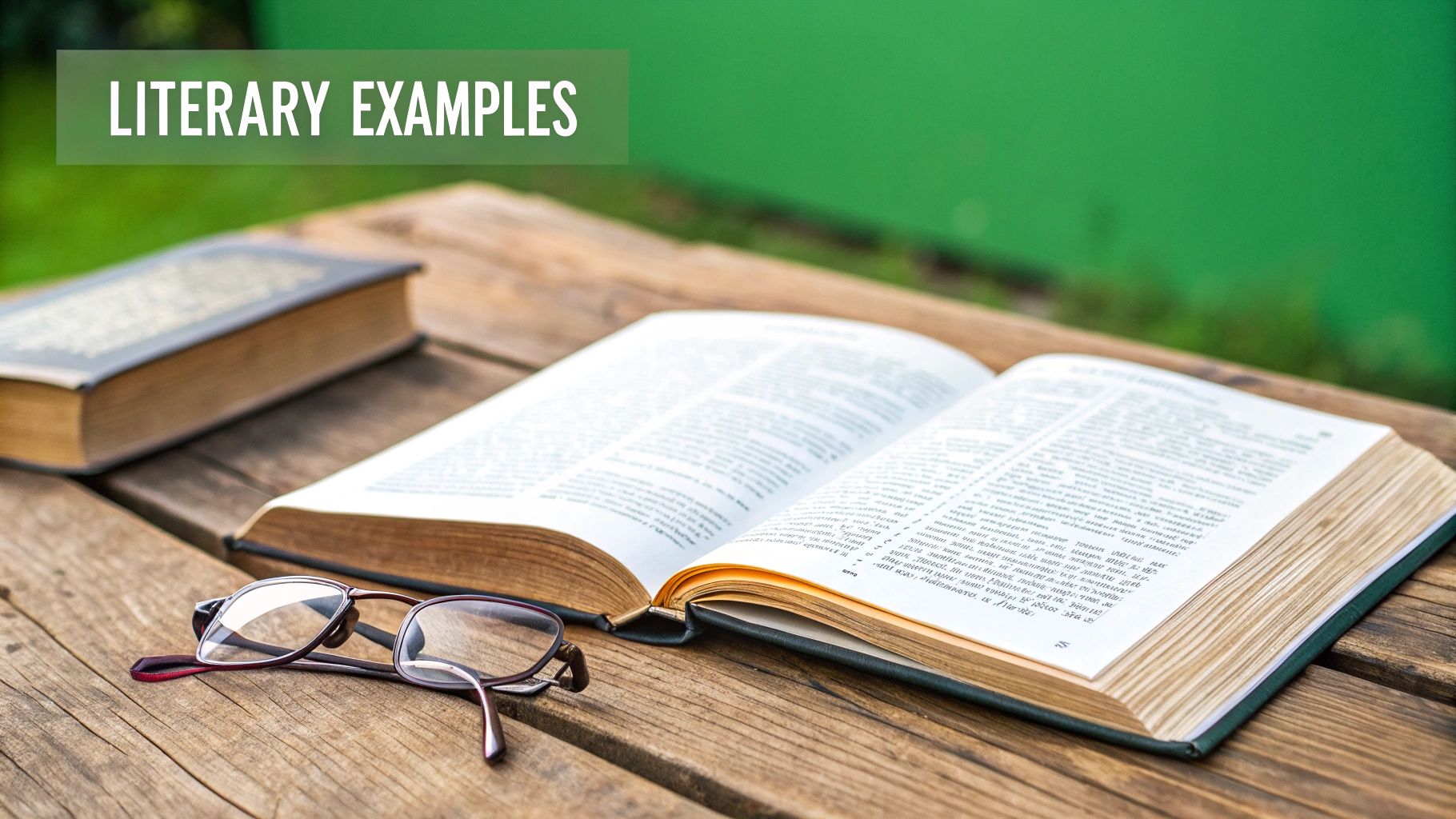
Think of every word as a brushstroke. Sensory details give your writing color and figurative language adds that artistic flourish, but the real foundation of a powerful image comes down to your individual word choice. The smallest tweaks can completely transform a sentence, sharpening a vague idea into something unforgettable.
This is where you stop just looking for a synonym and start thinking like a true wordsmith. It's about recognizing that words carry more than just meaning—they carry weight, sound, and a whole lot of feeling.
Moving Beyond Generic Language
The most common trap writers stumble into is using generic, catch-all words that don’t paint a specific picture. Your nouns and verbs are the engine of your sentences; if they're weak, the whole description falls flat.
Take this simple sentence:
- Before: The man walked down the street.
Sure, this tells us what happened, but it doesn't show us anything. "Walked" is a blank canvas. Now, let’s get specific with our verbs:
- After (Option 1): The man shuffled down the street. (This paints a picture of someone tired, old, or maybe injured.)
- After (Option 2): The man strutted down the street. (Now he sounds confident, maybe even a little arrogant.)
- After (Option 3): The man staggered down the street. (This suggests he's dizzy, drunk, or unwell.)
See how each verb creates a totally different character and mood without adding a single extra word? Using powerful action verbs lets the words themselves do all the heavy lifting for you.
Understanding Connotation and Denotation
Every word you choose has two layers of meaning. The denotation is its straightforward, dictionary definition. But the connotation is the emotional vibe or cultural baggage that comes along for the ride.
For instance, the words "thin," "slim," and "scrawny" all have similar denotations—they describe someone with little body fat. But their connotations are worlds apart:
- Thin is pretty neutral.
- Slim feels generally positive.
- Scrawny is definitely negative.
Mastering descriptive writing is all about choosing words for their connotative power. You're not just picking a word for what it means, but for what it implies. This careful selection is a huge part of shaping the overall feel of your writing. If you want to go deeper, exploring what is tone in writing can offer some great insights into how these choices create a consistent voice.
A writer's job is not just to select words that are correct, but to select words that are right. The right word doesn't just describe; it evokes, suggests, and resonates with the reader on an emotional level.
The Strategic Use of Adjectives and Adverbs
While strong verbs and specific nouns should be your go-to tools, adjectives and adverbs still have an important role. The trick is to use them strategically, not as a crutch to prop up weak words.
An adverb should add a layer of meaning that the verb can't convey on its own.
- Weak: He ran very fast. ("Fast" is already baked into "ran," and "very" is just filler.)
- Better: He ran desperately. (Now we have emotional context and motivation.)
Likewise, an adjective should provide an essential, illuminating detail. Instead of piling them on, pick the one or two that really count.
- Overwritten: The big, old, scary, dark house stood on the hill.
- Strategic: The skeletal house stood on the hill.
Here, that one word—"skeletal"—does more work than all four generic ones combined, creating a specific and unsettling image. When you're selective, you make sure every single word earns its spot in the sentence.
How Descriptive Writing Works in Different Fields
Descriptive writing isn't just for poets and novelists. Far from it. It's a surprisingly practical skill that gets results in a ton of professional fields. When you learn how to use it, you can turn bland, forgettable text into something that’s persuasive, clear, and memorable. It’s the secret sauce that transforms a simple product description into a must-have item or a dense report into a story people actually want to read.
No matter if you're writing a novel or a marketing email, the goal is the same: make your audience feel something. When you paint a vivid picture, you can sway decisions, explain tricky information, and build a genuine connection with your reader. This isn't just about adding pretty words—it’s about communicating effectively, period.
Transforming Marketing and Advertising
In marketing, description is the engine that drives persuasion. A list of features is just data. But a description that helps a customer imagine a better life? That’s an invitation they can’t refuse. The idea is to stop talking about what a product is and start showing what it does for someone on a sensory and emotional level.
Think about something as simple as a coffee maker.
- Flat Copy: "Our coffee maker has a 12-cup capacity and a programmable timer."
- Descriptive Copy: "Imagine waking up not to a jarring alarm, but to the rich, comforting aroma of freshly brewed coffee drifting from your kitchen. Our programmable brewer ensures a perfectly hot, full-bodied pot is waiting for you, turning every morning into a smooth, effortless start to your day."
See the difference? The second example doesn’t sell a machine; it sells an experience. This is more important than ever online. As digital content has evolved since 2010, the need for short, powerful descriptions that grab attention has exploded. Analytics show time and again that posts with strong sensory and emotional language get roughly 40% higher engagement rates than those without. You can dig deeper into how these insights are measured with descriptive statistics on Appinio.com.
Adding Clarity to Technical Writing
Technical writing might seem like the complete opposite of creative writing, but descriptive skills are crucial for making complex topics understandable. The best technical writers don’t just dump information; they build a bridge for the reader using analogies and relatable scenarios.
Let's say you need to explain cloud computing to someone who isn't a tech expert. It's a tough one.
A good technical writer might compare a server farm to a huge, digital library. They’d explain that your computer is like having just one book, but the cloud gives you a library card with instant access to endless shelves of information and tools, ready whenever you need them.
That simple analogy makes an intimidating topic feel accessible and helps the information stick.
Making Business Reporting More Compelling
Let's be honest, most business reports are packed with data, charts, and figures that can be incredibly dry. Descriptive writing helps tell the story behind the data, giving those numbers the context and meaning they need to make an impact.
Instead of just stating, "Q3 sales increased by 15%," a descriptive report would dig into the why. It could paint a picture of a knockout marketing campaign, describing the flood of positive customer feedback and the social media "buzz" that fueled the sales surge. By weaving a narrative around the data, you make the report more engaging and its conclusions more powerful for stakeholders. That's the role of descriptive writing in the corporate world—turning raw data into a compelling story.
Common Descriptive Writing Mistakes to Avoid
Even seasoned writers can fall into a few traps that drain the life from their descriptions. Knowing what descriptive writing is means mastering the techniques, sure, but it also means learning to spot these common pitfalls. Think of this as your field guide to keeping your prose sharp, clear, and impactful.
Get these right, and your writing will go from just fine to genuinely captivating. Every word will pull its weight.
The Problem with Purple Prose
You’ve probably seen it before. Purple prose is writing so over-the-top and ornate that it screams, "Look at me!" instead of letting you sink into the story. It’s choked with too many adjectives, tangled metaphors, and flowery language that just gets in the way. The writer might be trying to sound artistic, but the reader just ends up confused and exhausted.
- Mistake: "The cerulean orb of the sun descended majestically behind the undulating, amethyst-hued mountains, casting a tapestry of kaleidoscopic, incandescent beams across the firmament."
- Correction: "The sun slipped behind the purple mountains, sending a final splash of color across the sky."
See the difference? The second version is clean and effective. It trusts the reader to fill in the picture without being spoon-fed every last adjective. Good description should feel invisible—it serves the story, it doesn't show off the writer's thesaurus.
Relying on Clichés and Tired Phrases
A cliché is a comparison that’s been used so many times it's lost all its power. Things like "busy as a bee," "strong as an ox," or "raining cats and dogs." They feel familiar, but that's the problem. They're shortcuts, signaling to the reader that you've opted for a pre-packaged image instead of creating something new.
The goal of descriptive writing is to make the reader see something in a new way. A cliché does the opposite—it relies on an old, worn-out image that the reader has seen a thousand times before.
Instead of grabbing the first phrase that pops into your head, push yourself to find a fresh take.
- Cliché: "Her eyes were as blue as the ocean."
- Original: "Her eyes held the deep, stormy blue of a winter sea."
That small shift makes the description specific, memorable, and entirely your own.
Falling Back into Telling Instead of Showing
This is the big one. It’s the most fundamental mistake, and even experienced writers have to keep an eye out for it. Telling just states a fact or an emotion. Showing uses sensory details and actions to let the reader experience it firsthand.
Telling creates distance. Showing creates immersion. It's that simple.
Here are a few classic examples of this pitfall:
Telling: "He was angry."
Showing: "He balled his hands into fists, his jaw tight as he stared a hole through the wall."
Telling: "The house was creepy."
Showing: "A cold draft snaked through the room, carrying the scent of dust and decay as floorboards groaned upstairs."
Whenever you catch yourself telling the reader how a character feels or what a place is like, hit the pause button. Ask yourself: "How can I show this instead?" Making that mental shift is the key to unlocking truly powerful descriptive writing.
Frequently Asked Questions About Descriptive Writing
As you start weaving these techniques into your own work, questions will naturally pop up. It happens to every writer. Here are some straightforward answers to the most common ones I hear.
How Much Description Is Too Much?
There’s no magic word count, but here's a great rule of thumb: every description must have a job. Does it build the mood? Does it tell us something new about a character? Does it push the plot forward? If not, it might just be decoration.
If you're unsure, try reading the passage out loud. If you feel the pace dragging or find your own attention drifting, it’s a sign to trim it down. Weave those details into the action instead of letting them sit on their own.
The best description doesn't feel like description at all—it feels like an essential part of the story. Its goal is to be immersive, not decorative. When every detail has a job to do, you're on the right track.
Can I Use Descriptive Writing in a Professional Setting?
Absolutely. While you won't be writing like a novelist, descriptive techniques are incredibly useful in the business world.
- In marketing, it turns a boring product spec sheet into a vivid story that helps customers imagine themselves using it.
- In a business proposal, it can paint a clear picture of a successful outcome or clarify a complex process with a sharp analogy.
This isn't just for creatives. Clear, descriptive language is vital in fields from market research to healthcare. In fact, a 2023 report showed that around 97% of large companies believe descriptive writing helps them make better strategic decisions by clarifying market trends. You just need to match the tone to the context—keep it professional, but use description to add clarity and impact.
What's the Best Way to Practice My Skills?
Like any skill, you get better by doing it consistently. A fantastic exercise is to start a "sensory journal." Just go somewhere—a coffee shop, a park, your own kitchen—and spend 15 minutes writing down everything you see, hear, smell, taste, and touch. Don't worry about telling a story; just capture the raw details.
Another great trick is to take a dead-simple sentence, like "The man walked into the room," and rewrite it over and over. First, make it sound suspenseful. Then joyful. Then exhausted. This simple exercise is a great workout for building your word choice and mastering tone. For more ways to sharpen your craft, check out these 10 Proven Ways to Improve Writing Skills.
